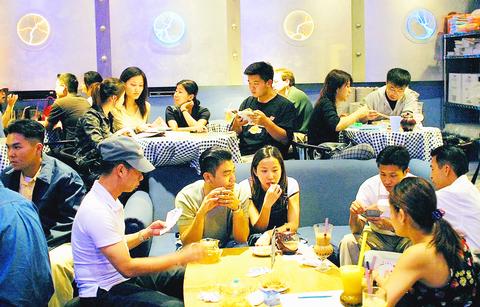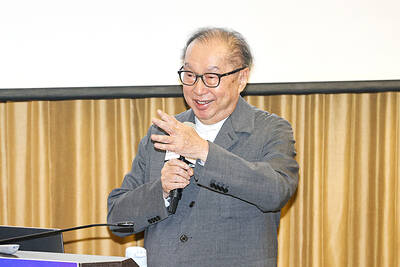On most nights, after the stores have been shuttered and the working people have turned off the lights, young Asian-Americans descend upon the Los Angeles suburb of San Gabriel and transform the main drag into an incandescent necklace of activity.
Outside, people wait in long lines, chat in a polyglot of Asian languages and rendezvous with friends from other area codes. Inside, they play cards, do homework and flip through Chinese comic books until 2am.
But mainly, they come for the pearl milk tea (

PHOTO: NY TIMES
Pearl milk tea is a drink, usually cold, that combines Asian tea, milk and marble-sized orbs of sweet, gooey tapioca that are sucked out with a plus-size straw. And in the last year or so, pearl milk teahouses have moved beyond their roots in the predominately Asian suburbs here and gained in popularity across the country, tickling palates in places like Houston, Washington and New York.
But here in the pearl milk tea capital of the US, the teahouses have always been more than just a food fad. They also magnetize young immigrants who are bored in the suburbs, lonely without their families and sometimes indifferent toward the American rituals of bar-hopping.
"This is like Starbucks for Asians," said Evie Prayogo, a 20-year-old student from Jakarta, Indonesia, who is studying accounting at the University of Southern California. She was testing a black pearl tea at a packed teahouse named Au 79 Tea Spirit on a recent Saturday night. Actually, Sunday morning.
"You can relax, you can talk, you can meet your friends," said Prayogo, who was gossiping with two Indonesian classmates. "Instead of sitting home alone, we can hang out here and stay as long as we like."
Pearl milk tea originated in Taiwan about 15 years ago, then spread to Hong Kong and Canada before reaching the West Coast about five years ago. Now, in the suburbs San Gabriel, Alhambra and Monterey Park, there are more than a dozen teahouses, compared with one five years ago.
Also known as bubble tea, the name refers to the tapioca balls at the bottom of the drink. The menus feature flavors such as passion fruit, taro and red bean. Some places offer free games such as cards and mahjong. Most sell inexpensive snacks including barbecued dry squid, fried tofu and Taiwanese sausages. Nothing costs more than US$5.
"Everywhere you go, it's like an Asian community," said Ko Li-cheng, a 20-year-old Taiwanese student at a Los Angeles fashion school who frequently parks himself at the CO2 Teahouse here.
"Sometimes I think, I spent thousands of dollars in tuition to leave Taiwan, and it's like I never left."
Some people, including Ko, sample as many teahouses as possible, up to four times a week. Some are very finicky: for Prayogo, the keys are quality control, an authentic tea taste and -- most important -- whether the tapioca is perfectly soft, chewy and sweet.
On Valley Boulevard, whose daytime personality tilts toward strip malls and chain supermarkets, many teahouses stay open until 11pm during the week and 2am or later on the weekends. And though most teahouses do not serve alcohol, the late hours have caused occasional friction, including noise complaints and scuffles.
"In terms of trouble, it's mostly minor stuff," said Lieutenant Al Brandvold of the San Gabriel Police Department. "But it's just astounding how many people are out at that time of night."
On a recent Saturday night at Tea Station, Anthony Wang, 34, a Vietnamese immigrant who lives in Westminster, about 40 minutes from San Gabriel, was displaying photos of his recent trip to Burma, Egypt and other places to four friends.
Blending Cantonese and English, Wang and his friends said they relished seeing friends in a comfortable setting.
"We all come in groups, so this is not a pick-up scene," said Wang, who works for a mortgage finance company.
Just a few traffic lights away, past pearl milk tea places such as Tapioca Express, there was barely a table to be had at the sleek Au 79 Tea Spirit.
It was past midnight, and the place was percolating with the cadences of Mandarin, Cantonese, English and Vietnamese. Some people had corralled the Friends-like couches. Some were staring at a bank of televisions playing Asian music videos. Some were thumbing through a stack of Asian-language magazines and comics.
At one table, Howard Ma, an animated 27-year-old telecommunications systems administrator, was holding court in Mandarin with four friends. They talked about some serious matters, including the terrorist attacks on the World Trade Center. But mostly, they were trying to dwell on life's pleasures. Like pearl milk tea.
"We don't drink [alcohol], we don't smoke," said Ma, an immigrant from Taiwan who lives in Cerritos, about a 30-minute drive from San Gabriel. "We just like to hang out and drink [pearl milk tea]."
Ma and his friends used to hang out in a different place: the chat rooms of Sina.com, a popular Chinese-language Web site. But after several months, a few of them decided to meet in person at the most logical place: a teahouse.

BYPASSING CHINA TARIFFS: In the first five months of this year, Foxconn sent US$4.4bn of iPhones to the US from India, compared with US$3.7bn in the whole of last year Nearly all the iPhones exported by Foxconn Technology Group (富士康科技集團) from India went to the US between March and last month, customs data showed, far above last year’s average of 50 percent and a clear sign of Apple Inc’s efforts to bypass high US tariffs imposed on China. The numbers, being reported by Reuters for the first time, show that Apple has realigned its India exports to almost exclusively serve the US market, when previously the devices were more widely distributed to nations including the Netherlands and the Czech Republic. During March to last month, Foxconn, known as Hon Hai Precision Industry

Taiwan Semiconductor Manufacturing Co (TSMC, 台積電) and the University of Tokyo (UTokyo) yesterday announced the launch of the TSMC-UTokyo Lab to promote advanced semiconductor research, education and talent development. The lab is TSMC’s first laboratory collaboration with a university outside Taiwan, the company said in a statement. The lab would leverage “the extensive knowledge, experience, and creativity” of both institutions, the company said. It is located in the Asano Section of UTokyo’s Hongo, Tokyo, campus and would be managed by UTokyo faculty, guided by directors from UTokyo and TSMC, the company said. TSMC began working with UTokyo in 2019, resulting in 21 research projects,

Ashton Hall’s morning routine involves dunking his head in iced Saratoga Spring Water. For the company that sells the bottled water — Hall’s brand of choice for drinking, brushing his teeth and submerging himself — that is fantastic news. “We’re so thankful to this incredible fitness influencer called Ashton Hall,” Saratoga owner Primo Brands Corp’s CEO Robbert Rietbroek said on an earnings call after Hall’s morning routine video went viral. “He really helped put our brand on the map.” Primo Brands, which was not affiliated with Hall when he made his video, is among the increasing number of companies benefiting from influencer

Quanta Computer Inc (廣達) chairman Barry Lam (林百里) yesterday expressed a downbeat view about the prospects of humanoid robots, given high manufacturing costs and a lack of target customers. Despite rising demand and high expectations for humanoid robots, high research-and-development costs and uncertain profitability remain major concerns, Lam told reporters following the company’s annual shareholders’ meeting in Taoyuan. “Since it seems a bit unworthy to use such high-cost robots to do household chores, I believe robots designed for specific purposes would be more valuable and present a better business opportunity,” Lam said Instead of investing in humanoid robots, Quanta has opted to invest